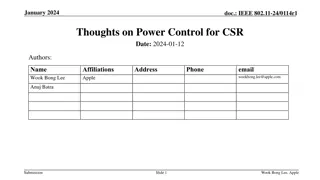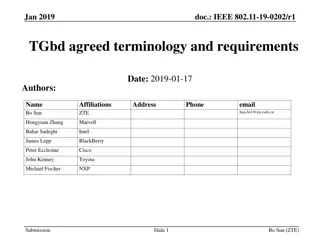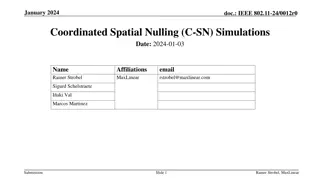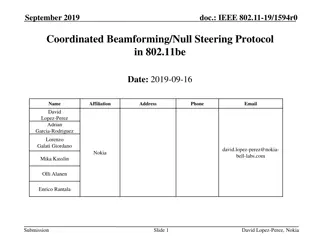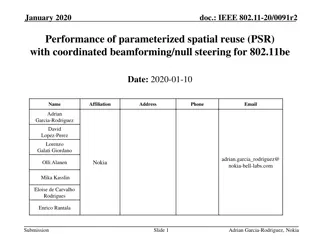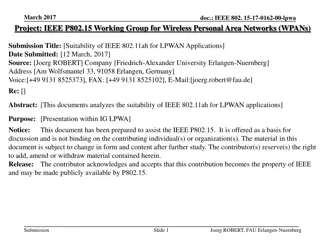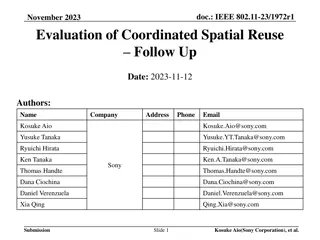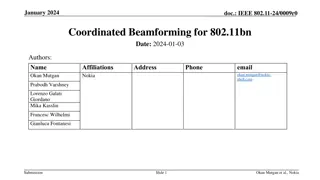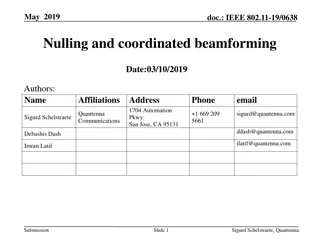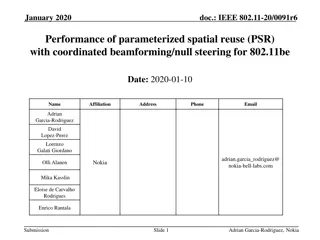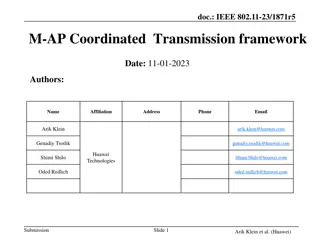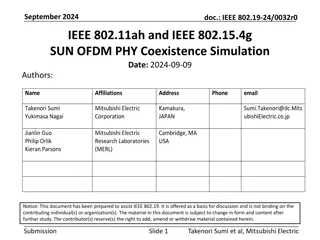Framework for Coordinated Access Points in IEEE 802.11-24/1220r2
"This document discusses a general framework for Coordinated Access Points (APs) in IEEE 802.11-24/1220r2, focusing on Multi-AP Coordination (MAPC) features to enhance latency and throughput. The framework includes capability advertisement, per-feature negotiations, container for MAPC information, signaling, and security measures. It delves into the phases of discovery, feature-specific negotiations, and frame exchanges for MAPC features like coordinated spatial reuse, beamforming, rTWT, and TDMA."
Download Presentation

Please find below an Image/Link to download the presentation.
The content on the website is provided AS IS for your information and personal use only. It may not be sold, licensed, or shared on other websites without obtaining consent from the author.If you encounter any issues during the download, it is possible that the publisher has removed the file from their server.
You are allowed to download the files provided on this website for personal or commercial use, subject to the condition that they are used lawfully. All files are the property of their respective owners.
The content on the website is provided AS IS for your information and personal use only. It may not be sold, licensed, or shared on other websites without obtaining consent from the author.
E N D
Presentation Transcript
Aug. 2024 doc.: IEEE 802.11-24/1220r2 A Framework for Coordinated Access Points Date: 2024-08-19 Authors: Name Affiliations Address Phone email Giovanni Chisci Qualcomm Technologies Inc. 5665 Morehouse Dr., San Diego CA 92121 gchisci@qti.qualcomm.com Abhishek Patil Gaurang Naik Alfred Asterjadhi George Cherian Duncan Ho Sherief Helwa Sanket Kalamkar Submission Slide 1 Giovanni Chisci et Al., Qualcomm
Aug. 2024 doc.: IEEE 802.11-24/1220r2 Introduction Multi-AP Coordination (MAPC) features are discussed for 11bn to improve latency and throughput and include coordinated spatial reuse (C-SR), coordinated beamforming (C-BF), coordinated rTWT (C- rTWT), coordinated TDMA (C-TDMA), etc. This presentation discusses a general framework for Coordinated APs: MAPC general framework Capability advertisement Per-feature negotiations Container for MAPC information Examples: negotiations and frame exchanges for some MAPC features Signaling Security Submission Slide 2 Giovanni Chisci et Al., Qualcomm
Aug. 2024 doc.: IEEE 802.11-24/1220r2 General framework Consider the set of MAPC features in 11bn (e.g., C-SR, C-BF, CrTWT, C-TDMA) Phase 1 (Discovery): A lightweight advertisement of capabilities for the set of supported MAPC features in 11bn No session/agreement establishment at this level (only advertisement) An AP can transmit this frame at will, eventually updating capabilities/parameters for MAPC features Management frames are used Phase 2 (Feature-specific negotiations): When a neighboring AP(s) with capability of a desired MAPC feature is discovered (e.g., after receiving the advertisement of Phase 1), negotiations can be carried out to establish a feature-specific agreement or update its parameters. Agreement is feature-specific (e.g., CrTWT/CTDMA/CBF/CSR agreement) Agreement (and associated messaging) is between a pair of APs Individually addressed Management frames are used Can include negotiation steps Negotiations can be optional/mandatory based on the specific MAPC feature If performed, at least agree on the intention to participate in the feature (request/accept/reject) If performed, may additionally agree on feature-specific parameters (via dedicated elements/subelements) Phase 3 (Feature-specific frame exchange) May or may not include more inter-AP communications depending on the feature E.g., for C-TDMA/C-BF/C-SR inter-AP frames specific to the feature may be exchanged for the operation (e.g., during a TXOP) E.g., for CrTWT, no inter-APs frame exchange during the operation AP BSS2 AP BSS1 Phase 1: capability exchange (management frames) Phase 2: Feature-specific negotiation (inter-AP individually addressed management frames) Phase 3: Feature-specific frame exchange Submission Slide 3 Giovanni Chisci et Al., Qualcomm
Aug. 2024 doc.: IEEE 802.11-24/1220r2 Example: CrTWT Negotiation and Frame Exchange Reuse the structure of 11be rTWT (based on B-TWT agreements) Phase 2 (Negotiation): Individually addressed management frames to negotiate a CrTWT agreement Negotiation is optional and can start after an AP discovers another capable AP Negotiation includes at least a request message containing the schedule to be protected and a response accept/reject The reference to the CrTWT agreement is the tuple {CrTWT ID, Requesting AP s MAC ID} Note: in 11be rTWT an agreement is referred to via the tuple {B-TWT ID, Scheduling AP s MAC ID} Phase 3 (Utilization): APs engaging in CrTWT perform the following: Owner AP: rTWT Information element with Broadcast TWT information with Broadcast TWT ID If the AP carries out negotiations with other APs, it should consistently use the B-TWT ID used for broadcasting the rTWT schedule in its own BSS as the value for the CrTWT ID used to obtain the agreement with the OBSS AP Non-owner AP: rTWT Information element with Broadcast TWT information with Broadcast TWT ID = 31 and Restricted TWT Schedule Information subfield set to 3 Note: can be used to signal to the non-owner AP s clients that it is an OBSS rTWT schedule Note: this is possible even if there is no formal CrTWT agreement between the APs Slide 4 Submission Giovanni Chisci et Al., Qualcomm
Aug. 2024 doc.: IEEE 802.11-24/1220r2 Example: CrTWT Negotiation and Frame Exchange AP BSS2 STA BSS2 STA BSS1 AP BSS1 MAPC Discovery Phase 1 MAPC Discovery CrTWT Request e.g., for a new agreement with CrTWT ID* Phase 2 CrTWT Response e.g., Accept agreement for the schedule in the Request frame rTWT Announcement over beacon (as in 11be rTWT) B-TWT ID = CrTWT ID* Phase 3 (OBSS) rTWT Announcement over beacon (e.g., as in 11be rTWT, with B-TWT ID = 31) CrTWT Request e.g., update SP parameters for CrTWT ID* Phase 2 CrTWT Response e.g., Reject the new parameters and tear down the agreement Submission Slide 5 Giovanni Chisci et Al., Qualcomm
Aug. 2024 doc.: IEEE 802.11-24/1220r2 Example: C-TDMA Negotiation and Frame Exchange Phase 2 (Negotiation): Individually addressed management frames to negotiate a C-TDMA agreement Negotiation can start after an AP discovers another capable AP Negotiation (if performed) includes at least a request message and an accept/reject message to establish the intention of sharing the TXOP Other parameters characterizing the traffic for which the TXOPs can be shared can also be negotiated Phase 3 (Utilization): APs can exchange frames at the TXOP granularity Submission Slide 6 Giovanni Chisci et Al., Qualcomm
Aug. 2024 Example: C- TDMA Negotiation and Frame Exchange doc.: IEEE 802.11-24/1220r2 AP BSS2 AP BSS1 MAPC Discovery Phase 1 MAPC Discovery C-TDMA Request e.g., for a new agreement between the 2 APs Phase 2 C-TDMA Response e.g., Accept agreement for the TXOP sharing TXOP level frame exchange Phase 3 C-TDMA Request e.g., update parameters Phase 2 C-TDMA Response e.g., Reject the new parameters and tear down the agreement Submission Slide 7 Giovanni Chisci et Al., Qualcomm
Aug. 2024 doc.: IEEE 802.11-24/1220r2 MAPC frames New Public Action frames can be used Appealing because they can be sent in unassociated state (clause 11.3.3) A new set of actions would be defined (see figure) For Negotiations (Phase 2) the Management frames should be individually addressed (pair-wise agreements) Defines specific action of the Action frame Set according to rules in Section 9.6 If Category is set to 4, this is the Public Action field . New values for the Action would be defined from reserved values, e.g.: 55: MAPC Advertisement 56: MAPC Negotiation Request 57: MAPC Negotiation Response Etc. MAPC Public Action frames Action Frame format in 11be MAC Header Category Action Frame contents Defines the category of the Action frame Set according to Table 9-81 Category is set to 4 (Public) Submission Slide 8 Giovanni Chisci et Al., Qualcomm
Aug. 2024 doc.: IEEE 802.11-24/1220r2 MAPC Discovery In the broadcast discovery frame, at least the following can be considered: One bit for capability/enablement of each feature This provides information about what MAPC features an AP supports (features that might be leveraged with or without negotiations depending on the deployment) Could indicate the presence of other reported feature-specific parameters One bit to allow/disallow negotiations Being saturated with negotiation agreements In case malicious devices are flooding with negotiation requests Submission Slide 9 Giovanni Chisci et Al., Qualcomm
Aug. 2024 doc.: IEEE 802.11-24/1220r2 MAPC Negotiation exchange (I) Co-SR Info A MAPC Negotiation can be a 2 frames exchange between a requesting AP and a responding AP The request frame should carry information for one or more negotiation categories (i.e., Co- RTWT, Co-TDMA, Co-BF, Co-SR) The response frame should carry the corresponding information from the responder side, including at least responses (e.g., status codes) for each request Note: AP ID assignment could be considered as one of the negotiations categories alongside Co-RTWT, Co-TDMA, Co-BF, Co- SR Co-TDMA Info Co-RTWT Info MAPC Negotiation Req. frame AP1 to AP2 MAPC Negotiation Resp. frame Co-RTWT Info Co-TDMA Info Co-SR Info Co-RTWT Info Co-BF Info MAPC Negotiation Req. frame AP2 to AP1 MAPC Negotiation Resp. frame Co-BF Info Co-RTWT Info Submission Slide 10 Giovanni Chisci et Al., Qualcomm
Aug. 2024 doc.: IEEE 802.11-24/1220r2 MAPC Negotiation exchange (II) An AP1 may send a MAPC Negotiation request to another AP2 only if it received a MAPC Advertisement with the Negotiations allowed bit set to 1. Note: should add request for features for which AP2 signaled that is capable of/has enabled An AP2 that receives a MAPC Negotiation request shall respond with a MAPC response. Submission Slide 11 Giovanni Chisci et Al., Qualcomm
Aug. 2024 doc.: IEEE 802.11-24/1220r2 MAPC element A new element for MAPC should be defined. The element should be able to carry information about the different per-feature negotiations There may be several options for how to include the per- negotiation category information, and those can be discussed going forward. Co-SR Info Co-TDMA Info Co-RTWT Info MAPC Negotiation Req. frame AP1 to AP2 MAPC Negotiation Resp. frame Co-RTWT Info Co-TDMA Info Co-SR Info Negotiation categories are: Co-RTWT, Co-TDMA, Co-BF, Co-SR, TBD AP ID assignment Submission Slide 12 Giovanni Chisci et Al., Qualcomm
Aug. 2024 doc.: IEEE 802.11-24/1220r2 Security MAPC negotiations with individually addressed Management frames should be encrypted. MAPC should consider reusing baseline procedures such as PASN (with extensions if needed) for pairwise encryption key. Group key derivation needs to be discussed. Secure delivery of group keys using pairwise key can be considered. The optionality of using MAPC security needs to be discussed. Submission Slide 13 Giovanni Chisci et Al., Qualcomm
Aug. 2024 doc.: IEEE 802.11-24/1220r2 Conclusion A framework for MAPC features is discussed including: Discovering MAPC features capabilities Negotiating engagement (for schemes) and parameters Utilization of the MAPC feature Signaling is discussed based on: Public action Management frames (new actions for MAPC) New MAPC element Security based on PASN Submission Slide 14 Giovanni Chisci et Al., Qualcomm
Aug. 2024 doc.: IEEE 802.11-24/1220r2 SP1 Do you support that an AP supporting Coordinated AP (MAPC) features shall be able to discover a neighbor AP that indicates support of MAPC features and may initiate a negotiation(s) for coordination with the neighbor AP? Submission Slide 15 Giovanni Chisci et Al., Qualcomm
Aug. 2024 doc.: IEEE 802.11-24/1220r2 SP2 Do you agree that APs that intend to participate in MAPC feature(s) can use management frames to advertise/discover the capability and/or parameters of individual MAPC features Submission Slide 16 Giovanni Chisci et Al., Qualcomm
Aug. 2024 doc.: IEEE 802.11-24/1220r2 SP3 Do you agree that APs that discovered each other and want to establish an agreement for a specific MAPC feature, can use individually addressed management frames to establish the agreement and negotiate parameters Note: The management frame can be a Public Action and/or new Action frames Submission Slide 17 Giovanni Chisci et Al., Qualcomm
Aug. 2024 doc.: IEEE 802.11-24/1220r2 SPa1 (MAPC Public action frame actions) Do you support to define new actions for Public Action frames for MAPC communications such as discovery and negotiations? A new action is defined for MAPC Discovery An action is defined for MAPC Negotiation Request An action is defined for MAPC Negotiation Response Others are TBD Submission Slide 18 Giovanni Chisci et Al., Qualcomm
Aug. 2024 doc.: IEEE 802.11-24/1220r2 SPa2 (M-AP coordination discovery) Do you support that when an AP use Management frames to discover the capabilities and/or parameters of individual M-AP coordination schemes, the AP shall use the defined MAPC Public Action frame with the following setting: The action field is set to MAPC Discovery Submission Slide 19 Giovanni Chisci et Al., Qualcomm
Aug. 2024 SPa3 (M-AP coordination negotiations - Request) doc.: IEEE 802.11-24/1220r2 Do you support that, when an AP (AP1) uses an individually addressed Management frame to initiate a negotiation to establish agreements for M-AP coordination schemes (if enabled by another AP (AP2)), the AP (AP1) shall use the defined MAPC Public Action frame with the following setting: The action field is set to MAPC Negotiation Request o If new negotiations are disabled by another AP (AP2) the AP (AP1) shall not send a negotiation request the other AP (AP2) TBD details of new negotiations disabled o Submission Slide 20 Giovanni Chisci et Al., Qualcomm
Aug. 2024 SPa4 (M-AP coordination negotiations - Response) doc.: IEEE 802.11-24/1220r2 Do you agree that when an AP (AP2) receives an individually addressed Management frame that initiates a negotiation to establish agreements for M-AP coordination schemes, the AP (AP2) shall respond by using the defined MAPC Public Action frame with the following setting, if the negotiation is not disabled: The action field is set to MAPC Negotiation Response o Submission Slide 21 Giovanni Chisci et Al., Qualcomm
Aug. 2024 doc.: IEEE 802.11-24/1220r2 SPc1 (Co-RTWT Parameters Set) A Co-RTWT Requesting AP, shall include one or more Co-RTWT Parameter Set fields corresponding to each requested R-TWT schedule in the TBD individually addressed management frame used for the request to the Co-RTWT Responding AP. The Co-RTWT Parameter Set field includes the following: Target Wake Time field Broadcast TWT ID field Broadcast TWT Persistence TWT Wake Interval Mantissa TWT Wake Interval Exponent Nominal Minimum TWT Wake Duration TBD other fields Submission Slide 22 Giovanni Chisci et Al., Qualcomm
Aug. 2024 doc.: IEEE 802.11-24/1220r2 THANK YOU Submission Slide 23 Giovanni Chisci et Al., Qualcomm




